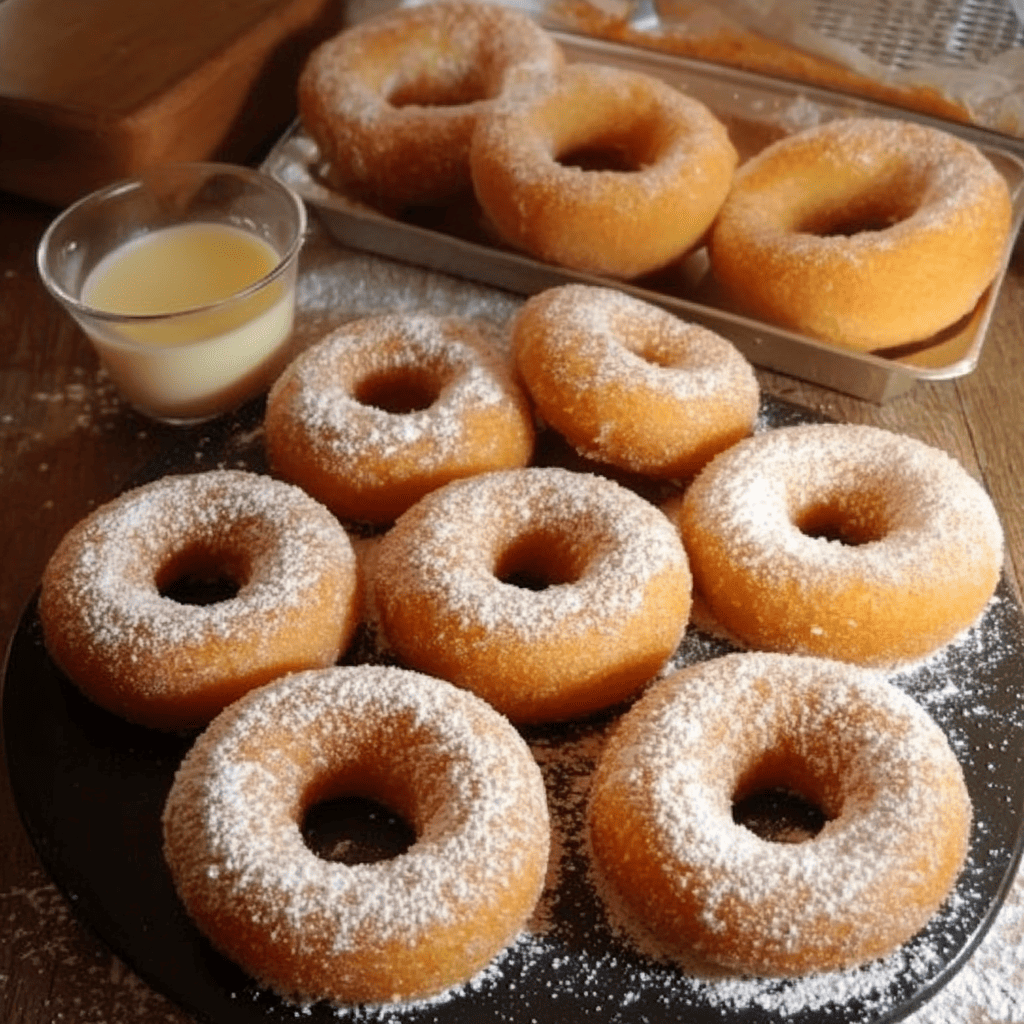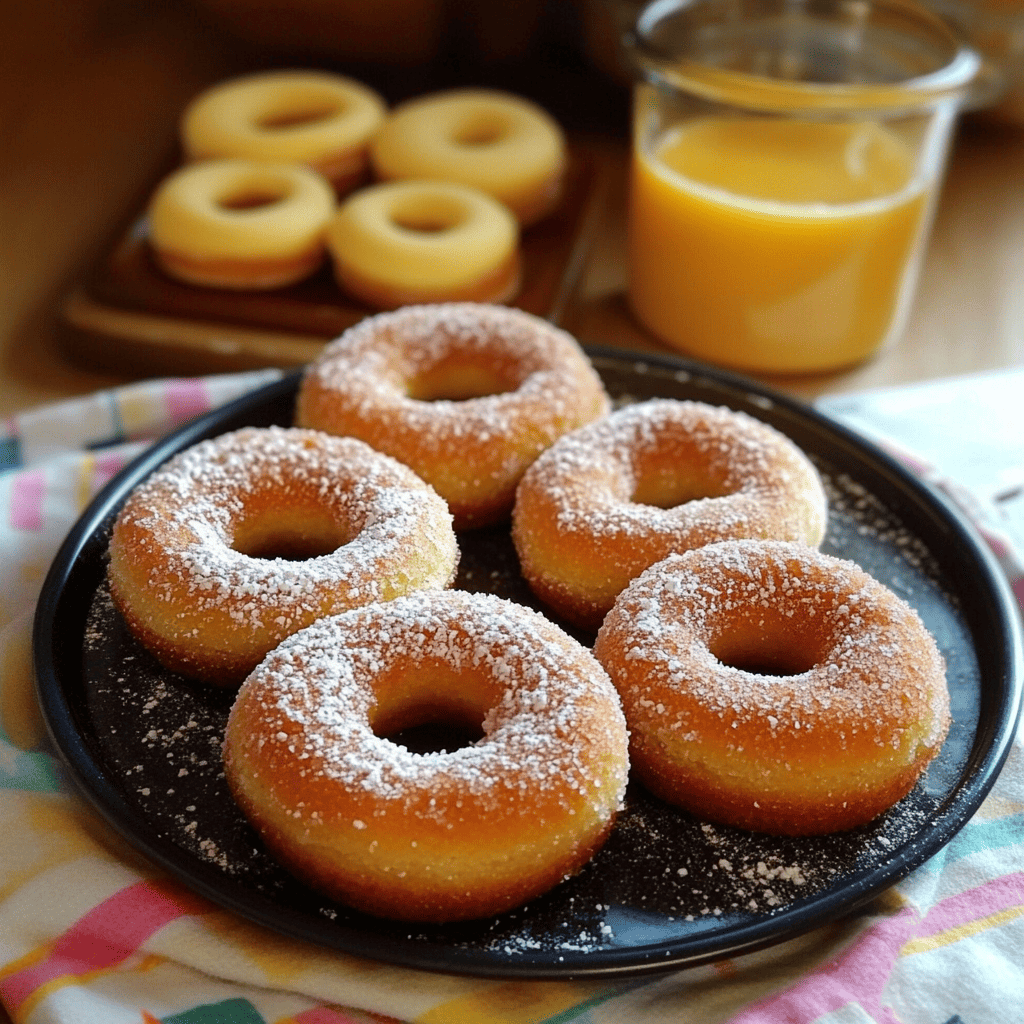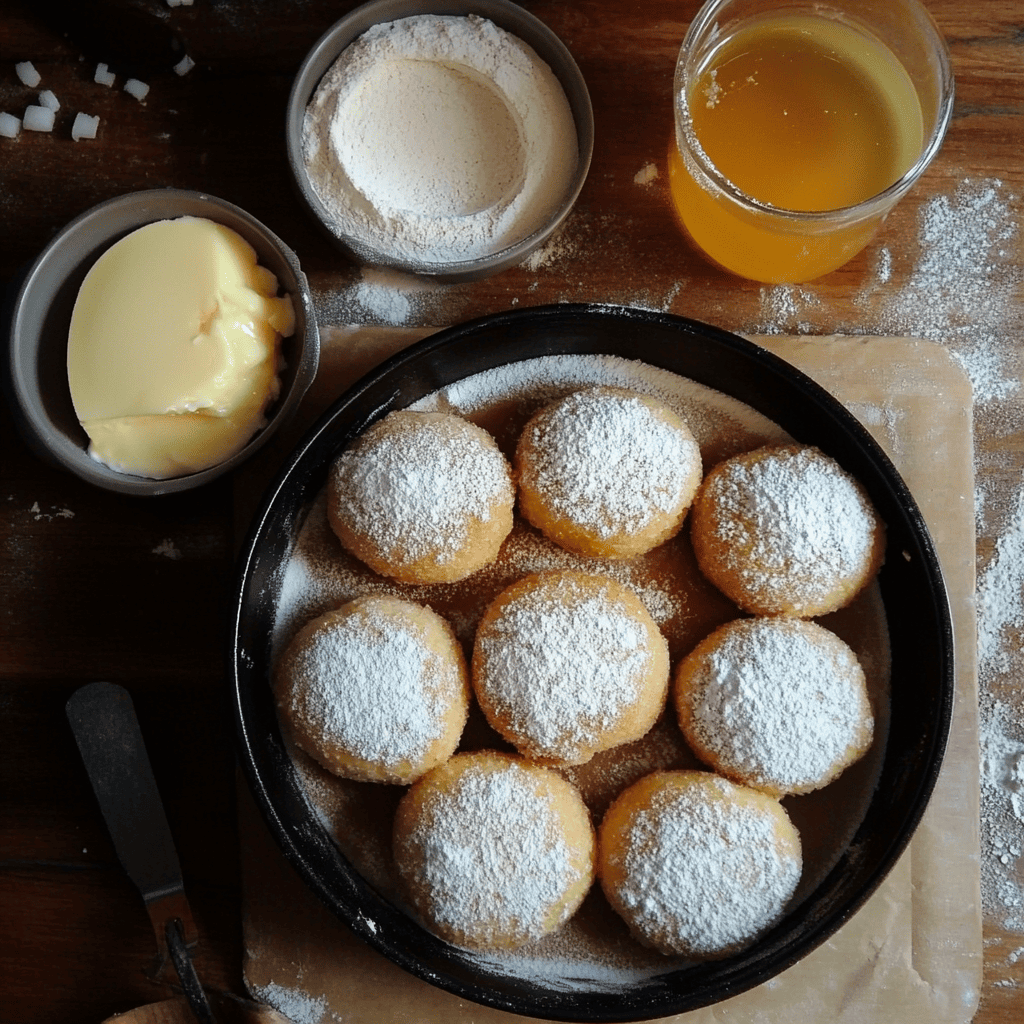Sugar Donuts: A Sweet and Fluffy Classic
Introduction
Sugar donuts are a classic and popular dessert around the world, but they hold a special place in homemade baking. Soft, fluffy, and generously coated with sugar, these treats are ideal with coffee, hot chocolate, or simply enjoyed on their own. Making them, while requiring patience due to the dough’s fermentation time, is relatively simple and accessible for anyone looking to make a homemade dessert with basic ingredients.
Sugar donuts are a classic pastry treat worldwide, known for their softness, sweetness, and spongy texture. This delicious sweet bread has won over generations, making it an irresistible choice for breakfast, a snack, or any time of day. The combination of airy dough, fried to a perfect golden brown, and coated with a layer of sugar creates a unique sensorial experience that evokes memories of childhood and family traditions.
In many countries, donuts have evolved to adapt to different tastes and cultures, with variations in ingredients, preparation methods, and presentation. In Mexico, for example, sugar donuts are a traditional staple in bakeries and markets, where they are sold freshly made, with a slightly crunchy exterior and a soft, light interior.
Making them at home allows you to enjoy a fresher and more customizable product, as well as being a fun and rewarding activity. Although the process requires patience due to the fermentation time, the result is worth it: homemade donuts with an authentic flavor and an unparalleled texture.
In this article, we’ll explore the history of donuts, their ingredients, and their step-by-step preparation, along with some tips for achieving the best version of this classic dessert.
History of Donuts
The origin of donuts is not entirely clear, but their history is believed to date back to the Netherlands in the 17th century, when Dutch immigrants brought a recipe for fried buns called olykoeks (oil cakes) to North America. Over time, this recipe evolved, and in the 19th century, the idea of making a hole in the center to allow for more even baking became popular, giving rise to the donut as we know it today.
Sugared donuts, in particular, have been a staple of home baking in many countries, adapting to different cultures and tastes. In Mexico, they are common in bakeries and markets, where they are enjoyed for breakfast and snacks, accompanied by café de olla (coffee pot) or atole (a type of atole).
Doughnuts , also known as doughnuts , have a fascinating history dating back centuries. Although they are now a popular dessert around the world, their origin is a matter of debate. It is believed that they were introduced to North America by Dutch immigrants in the 17th century, who prepared a primitive version called “olykoeks” or “oil cakes.” These were small pieces of dough fried in hot fat, similar to modern doughnuts but without the characteristic hole in the center.
Origin and Evolution
As this recipe became popular in the United States, modifications began to be made to improve its texture and flavor. In 1847, an American sailor named Hanson Gregory claimed to have been the first to create the hole-in-the-wall donut. According to legend, Gregory pierced the dough to ensure it cooked evenly, as the center often remained raw. This innovation allowed the donuts to acquire their classic shape and made them easier to bake.
During World War I, doughnuts gained even more notoriety when the “Doughnut Lassies ,” a group of female volunteers from the Salvation Army, began making them for American soldiers on the front lines. These homemade doughnuts offered a moment of comfort and familiarity to the soldiers, which contributed to their popularity upon returning home.
Donuts Today
Today, donuts have evolved and become one of the most beloved treats in the world. There are countless variations, including glazed, filled, chocolate-covered, sugar-dusted, and many more. In addition, countries like Mexico have incorporated their own donut styles, featuring ingredients and flavors typical of local cuisine.
Sugar donuts, in particular, have remained one of the most traditional and easiest versions to prepare at home. Their simplicity and delicious flavor have made them a beloved dessert in bakeries, fairs, and cafes around the world.

Ingredients and Preparation
Ingredients:
- 1 kilo of flour
- 1 cup of refined sugar
- 11 grams of dry yeast
- 2 eggs
- ½ cup of vegetable shortening
- 2 teaspoons of vanilla essence
- 2 cups of warm water
- 1 liter of oil for frying
- 1 cup of sugar to cover the donuts
Step by Step Preparation:
- Dough Preparation: In a large bowl, mix the flour, sugar and yeast.
- Stirring in wet ingredients: Make a well in the center and add the eggs, shortening, vanilla extract, and one cup of warm water. Mix until the shortening dissolves and add the remaining water little by little.
- Kneading: Knead the mixture until you have a smooth, elastic dough that doesn’t stick to your hands (about 15 minutes). You can use a mixer with a dough hook if you prefer.
- Fermentation: Grease a bowl with oil and place the dough inside. Lightly oil the surface of the dough and cover it with a clean cloth. Let it rest until it doubles in size.
- Forming the donuts: Roll out the dough on a floured surface and cut out circles with a donut cutter.
- Second rest: Place the donuts on a floured tray, cover them with a cloth, and let them rise for another hour.
- Frying: Heat the oil to 180°C and fry the donuts for approximately 3 minutes per side, until golden brown.
- Sugar coating: Remove the donuts from the oil and place them on paper towels. While they’re still warm, coat them with powdered sugar to help them adhere.
Tips for Perfect Donuts
- It is important to respect the fermentation times to achieve a spongy texture.
- Make sure the oil is at the right temperature before frying the donuts. If it’s too hot, they’ll brown quickly on the outside but remain raw on the inside.
- If you prefer an extra touch of flavor, you can add cinnamon to the refined sugar before coating the donuts.
- For a lighter version, you can also bake them instead of frying them.

Questions about Sugar Donuts
- What is the origin of donuts and who is considered their creator?
- Why do traditional donuts have a hole in the center?
- How were donuts prepared during World War I and who made them?
- What basic ingredients are needed to make sugar donuts?
- What is the function of yeast in the preparation of donuts?
- Why is it important to let the dough rise before frying the donuts?
- What temperature should the oil be at to fry donuts properly?
- What variations of donuts exist in different countries?
- How can donuts be made healthier without losing their traditional flavor?
- What drinks are ideal to pair with freshly made sugar donuts?
More Information about Sugar Donuts
- Donut Varieties: In addition to sugar donuts, there are other options such as those filled with cream, covered in chocolate, with flavored glaze, or decorated with colored sprinkles.
- Cooking Alternatives: Although the traditional recipe uses frying, some modern versions include baked or air-fried donuts to reduce the fat content.
- Regional Flavors: In Mexico, it’s common to find donuts filled with cajeta, dulce de leche, or pastry cream. In other countries, ingredients like matcha, cinnamon, or tropical fruits are used.
- Preparation Tips: To obtain a fluffy texture, it is essential to respect the fermentation time and not over-knead the dough to avoid tough donuts.
- Creative Decoration: To add a special touch, donuts can be covered with cinnamon sugar, powdered sugar, or even a colored glaze.
Sugar donuts remain an irresistible and easy-to-make dessert, perfect for sharing at family gatherings, breakfasts, or snacks. Enjoy them with coffee, hot chocolate, or your favorite beverage!
Texture and flavor
- Texture: Soft and spongy on the inside and slightly crispy on the outside. When fried thoroughly, they achieve a light and airy crumb.
- Flavor: Sweet, with a subtle vanilla aroma. The sugary exterior gives it a delicious grainy texture when you bite into it.
Estimated preparation time
- Dough preparation: 20 minutes
- Rest for rising: 1 hour
- Forming and second rising: 30 minutes
- Fry: 20 minutes
- Approximate total: 2 hours 10 minutes
Consumer context
- Perfect for breakfast or a snack.
- Very common at fairs, traditional bakeries and street sales.
- They go well with a pot of coffee, milk or hot chocolate.
Visual appearance
- Uniform golden color, covered with a generous layer of white sugar.
- They have the classic round shape with a hole in the center (although some versions can also be filled).
Curiosities
- Doughnuts came to Mexico through American influence, but have been adapted to local tastes (such as versions with sugar, cinnamon, or even cajeta).
- In some regions they are known as “fried donuts.”
- They are a popular choice in schools, offices, and street vendors.
Estimated nutritional value (per medium donut):
- Calories: 180 – 250 kcal
- Fats: 8 – 12 g
- Carbohydrates: 30 – 35 g
- Sugars: 10 – 15 g
- Protein: 3 – 4 g
(Values may vary depending on size, amount of oil absorbed, and coverage.)
Additional benefits and interesting facts
- Although they are an indulgent food, they can be made at home with controlled ingredients and less oil.
- You can experiment with baked versions for a lighter option.
- They accept a variety of coatings: chocolate, cinnamon sugar, colored icing, etc.

Conclusion
Sugar donuts are a classic dessert that combines a fluffy texture with a sweet and comforting flavor. Although they require some time to rest, they are simple to prepare and allow you to enjoy delicious homemade bread. Rooted in the baking tradition and a strong presence in Mexican cuisine, these donuts are a perfect option to share with family and friends on any occasion.
Sugar donuts are a classic and timeless dessert that has won over the palates of millions of people around the world. Their origin dates back to ancient times, but their popularity grew significantly with industrialization and the creation of variations in different cultures. Today, donuts not only represent a delicious treat, but also a symbol of tradition, creativity, and culinary evolution.
Preparing sugar donuts requires patience and precision, from properly raising the dough to the ideal oil temperature for frying. Each step is key to achieving a fluffy texture and balanced flavor. Furthermore, although the traditional recipe involves frying, there are healthier alternatives, such as baking or air frying, that allow you to enjoy this delicacy with less fat without sacrificing its essence.
Their versatility is another reason they remain so popular. They can be customized with different toppings, fillings, and decorations, adapting to different tastes and preferences. Plus, they’re ideal for any occasion, whether it’s breakfast, a snack, or a special event.
Ultimately, sugar donuts are not only a culinary delight, but also a sensorial experience that combines history, culture, and flavor in every bite. Making them at home allows you to experiment with ingredients, techniques, and presentations, making them a perfect option to enjoy and share with family and friends. Nothing beats the pleasure of a freshly made donut, crispy on the outside and soft on the inside!

